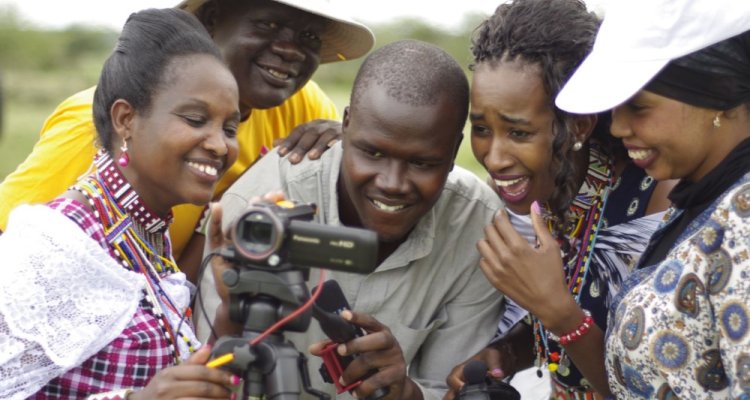
Impact story
Unique ‘landscape learning journeys’ on climate resilience empower communities in the Horn of Africa
How can vulnerable communities in the Horn of Africa deal with climate change? How can they make their landscapes more resilient, while learning from each other and operating as a network? In the 'Landscape Learning Journey' project, landscape facilitators from six countries in the Horn of Africa travelled to each other's landscapes and by collective learning focussed on finding practical solutions to climate change and landscape governance issues.
The Landscape Learning Journey is a collaboration of the Horn of Africa Regional Environmental Center & Network (HoA-REC&N) and the Wageningen Centre for Development Innovation (WCDI) of Wageningen University & Research. Ilse Hennemann, advisor environmental governance & climate change at WCDI, and colleague Cora van Oosten were responsible for the capacity building process during the journeys. Hennemann: 'Our strength at WCDI is to put knowledge into action. In this project, we wanted to establish a real learning journey, where travelling to each other's landscapes and taking up critical knowledge, skills and attitude, was directly brought into practice by the landscape facilitators. It's extremely powerful to see how climate change is impacting various landscape functions and its people inhabitants. After analysis, we then jointly developed landscape action plans addressing climatic and non-climatic drivers of change.
Understanding multi-stakeholder processes
Before the learning journey started, HoA-REC&N identified six landscapes with high vulnerability to climate change effects in the countries Djibouti, Sudan, South Sudan, Somaliland, Ethiopia and Kenya. Focus of the learning journey was to take on a landscape perspective while addressing climate challenges. This means to look beyond sectors or value chains and to take into account natural systems as well as social systems.
Fatouma Abdillahi, landscape facilitator from Djibouti, was one of the participants in the learning journey: "My eyes were really opened to a broader understanding of a landscape and the role communities play. I now understand who the stakeholders are, what their interests are, and how I can better collaborate with them as a facilitator. Through the WCDI-trainings, I learned how to prioritise activities and communicate messages clearly, not just through the sharing of experiences but also by taking part in the process and learning from our landscapes."
Learning events
The Landscape Learning Journey was set up in such a way that every six months a 'learning event' was organised around one specific theme and took place in on the of six landscapes. The themes ranged from vulnerability assessments to stakeholder engagement strategies and the development of landscape business cases. In order to promote consistency and build on previous learnings, the same group of landscape facilitators, consisting of staff from community based organisations and local universities, participated in these learning events. This approach also allows to look beyond the regional differences. Hennemann: "You're looking at very diverse regions: different religions, ethnicities, nationalities and languages. In spite of the differences between those landscapes, we realised during the learning events how many of the challenges were actually quite similar."
Landscape governance framework
WCDI worked with participants on developing a framework for establishing landscape-specific approaches, turning analysis into action. The framework helped to structure thinking and identify priority areas for intervention, according to Hennemann.
Parashina Lampat, landscape facilitator from Kenya, is enthusiastic about this approach: "The Landscape Governance Framework takes centre stage and in every training session we focussed on a different component of it, without losing sight of our objectives or straying into other topics. The framework gave us structure."
The framework also provides the foundation for a coherent narrative about the landscape. Hennemann: "By analysing the building blocks of the framework, you also create a landscape narrative: What makes this landscape unique, what challenges does it face, who are the stakeholders and how do they co-shape the landscape? Which institutional change is needed to address climate change? We also looked at the economic opportunities that can be derived from landscape functions. By identifying those components and making them explicit, we built a landscape story that helps to identify pathways for change. This also applies to participatory storytelling. How do you tell a story about the most important changes in the landscape?"
Most Significant Change stories
Many of the action plans at landscape level developed during the learning journeys, were implemented - with some impressive results: development of participatory land use managements plans, construction of water storage systems, introduction of improved cooking stoves, youth employment in solar panel maintenance and organising awareness raising campaign. University curricula were developed as well as national and regional policies made more landscape sensitive.
In cooperation with a filmmaker a participatory evaluation method called 'The Most Significant Change (MSC) method was used to identify progress and show impacts of interventions. All of the landscape facilitators were trained in this method, and eventually the MSC stories were filmed by the facilitators themselves – and turned into nine short MSC-video's.
"We shared our learnings with our landscape partners, but also with our governments, and even with IGAD, our regional governance body, that can use our learnings in creating more transboundary collaboration", says Fatoumi Abdillahi from Djibouti.
Training of trainers
It' is currently unclear whether there will be a follow-up to the project. One option is for the existing facilitators to give landscape training to beneficiaries ('training of trainers'). Hennemann says that the framework is now also being used in other countries, such as in the Philippines, where they have tailored and translated the framework that it fits their local context.